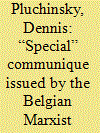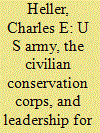|
|
|
Sort Order |
|
|
|
Items / Page
|
|
|
|
|
|
|
| Srl | Item |
| 1 |
ID:
137796


|
|
|
|
|
| Summary/Abstract |
This section of Studies in Conflict & Terrorism is dedicated to the reprinting of selected, translated terrorist communiqués that provide insights into the mindset, worldview, or operational thinking of a group. In terms of communiqués, this section employs the following typology of terrorist communiqués. There are three types of terrorist communiqués: attack, strategic, and special. Attack communiqués are issued to claim responsibility for an attack, explain the target selected, and provide the political rationale for attacking the target. A strategic communiqué is a longer document that is issued to provide strategic direction or commentary on political events, issues, and developments relevant to the group's cause and constituency. It can be used to explain changes of strategy or reinforce the strategic direction of the group. The special communiqué is similar to the attack communiqué in that it is event-driven but addresses non-attack events like anniversary dates, hunger strikes, elections, deaths of leaders, ceasefires, issuing threats or warnings, annual progress reports, issuing apologies, and so on. All three communiqués are issued publicly and intended to influence various audiences.
|
|
|
|
|
|
|
|
|
|
|
|
|
|
|
|
| 2 |
ID:
094812


|
|
|
|
|
| Publication |
2010.
|
| Summary/Abstract |
Prior to World War II, the U.S. Army numbered 187,000 soldiers. Its growth to more than 8 million was a significant accomplishment. Little known to most, the Franklin D. Roosevelt administration's youth program, the Civilian Conservation Corps (CCC), provided the pretrained manpower to fill the U.S. Army's ranks upon mobilization with men who readily assumed the role of Non-Commissioned Officers (NCOs). It also gave Organized Reserve Corps officers the opportunity to occupy leadership positions, an experience that would have been unavailable otherwise. By the same token, it allowed the Regular Army to assess the leadership potential of both Regular and Reserve Officers in leading future citizen soldiers. Last, it provided the Army with an opportunity to exercise its mobilization plans.
|
|
|
|
|
|
|
|
|
|
|
|
|
|
|
|
|
|
|
|
|